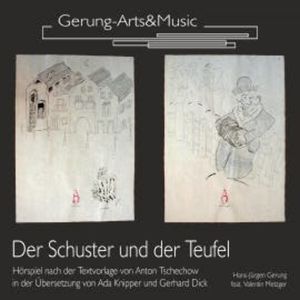Der Schuster und der Teufel.
Während einiger Unterrichtsstunden entstand 1999 das erste Manuskript zur Märchenvertonung Der Schuster und der Teufel nach dem Text von Anton Teschechow (in der Übersetzung von Ada Knipper und Gerhard Dick, 1965 aus: Anton Teschechow. Die Steppe. Meistererzählungen. Rütten & Loening, Berlin, 1965 – Aufbau Verlag GmbH & Co. KG, Berlin 1965, 2008). Die Komposition ist für Sprecher, Gitarre, Laute, Orgel und Akkordeon und erzählt die Geschichte des armen, aber schlauen Schuhmachers Fëdor Nilov, der an Heiligabend einen seltsamen Pakt mit dem Teufel schließt.
Das Thema ist natürlich immer dasselbe von Reichtum, Macht und Wohlbefinden, als Gegenleistung für die verkaufte Seele - aber Teschechows Variation des Topos hält viele Überraschungen bereit …
Die Musik ist vor allem Programmmusik und das Werk folgt dem Prinzip der Leitmotivkomposition und liefert somit eine äußere Form, die dem Schüler, durch ständigen Abgleich zwischen handelnder Person und zugehöriger Musik, verständnisvoll vermittelt, warum eine Musik an einer bestimmten Stelle gerade so geschrieben wurde.
___
The Shoemaker and the Devil.
During some lessons, the first manuscript for the fairy tale adaptation The Shoemaker and the Devil was written in 1999 according to the text by Anton Chekhov (translated by Ada Knipper and Gerhard Dick, 1965): Anton Teschechow, Die Steppe. Meistererzählungen. Rütten & Loening, Berlin, 1965 - Aufbau Verlag GmbH & Co. KG, Berlin 1965, 2008). The composition is for speaker, guitar, lute, organ and accordion and tells the story of the poor but clever shoemaker Fëdor Nilov, who on Christmas Eve makes a strange pact with the devil.
Of course the theme is always the same of wealth, power and well-being, in return for the sold soul - but Anton Chekhov's variation of the topos holds many surprises in store ...
Above all, the music is program music and the work follows the principle of the Leitmotivkomposition and thus provides an outward form, which communicates to the student, through constant alignment between the actor and the associated music, understanding why music was written in a particular place just like that.
